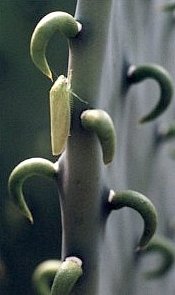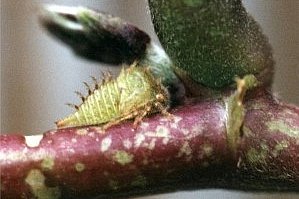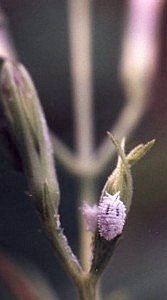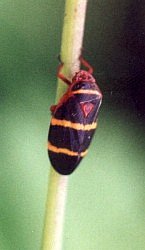Homoptera
by Valerie (October 12, 2000)
revised August 24, 2002
Infamously known as major pests in the garden, all insects of the order Homoptera (or suborder, according to some taxonomists) feed on plants, sucking out their sap or juices. This group includes such members as cicadas, spittlebugs, treehoppers, leafhoppers, whiteflies, aphids, scale insects, lac insects, and mealybugs. There are many wingless forms and odd-shaped insects, and the majority of species are very tiny.
Pest infestations are not a big concern within our gardens, as there is so much diversity that any given pest can only eat a small percentage of the vegetation. It also seems that most problems with destructive insects are curtailed by helpful predators. However, the tiny homopterids are quite interesting and a real challenge to photograph because of their small size.
The first insects pictured are the familiar aphids, here feeding on a Mexican milkweed, or butterfly weed. Aphids are very prolific and can produce dozens of generations in a single season. Particularly unusual is that most of the generations are the result of parthenogenesis, or females producing more females without the fertilization of males. Adding to the rapidity of reproduction, the young aphids are born alive and ready to eat, thereby bypassing the delay of hatching from an egg. Only late in the season do the males begin to appear. Then the aphids mate and produce eggs which will survive the winter.
Aphids are frequently preyed upon by all sorts of predatory insects, including ladybird beetles and their larvae, lacewings and larvae, and various small assassin bugs. In this photo, there is a syrphid fly maggot barely visible as it stalks around the base of a leaf in the lower left center. These maggots feed on the aphids.
Out of three large Chinese parasol trees, all in the same part of the yard, one developed quite a coating of scale insects on its trunk. These tiny white pests prefer trees and shrubs with smooth bark and the parasol tree certainly filled the bill. In spite of predation by twice-stabbed ladybird beetles, the scale continued to cover the lower part of the trunk of this tree for the entire summer.
Leafhoppers come in a variety of colors, including brown and red/blue striped, but one of the more common is the small green variety seen here on a young prickly pear cactus pad. These insects have well-developed wings and also strong legs so they jump and fly easily. Even though they have adequate escape mechanisms, they often prefer to rely on their camouflage color and will stay very still when I get close.
The final insect pictured is the mealybug. They have this name because of the white powder that covers them. We never have very many of this creature in our gardens and, in this case, there were just two feeding on a native wildflower called violet ruellia. The adult male mealybugs have wings and can fly but the females remain flightless. This female is about ¼ inch long, the males are smaller. |


 Closely related to leafhoppers, treehoppers are shaped differently. They are thicker, usually with a big hump on their back. The larva shown at left is a three-cornered alfalfa hopper. This common insect can become a pest on crops such as soybeans and peanuts, but we only see occasional individuals. It has distinctive spines on its back and blends in well with the surrounding foliage. The nymph cannot fly and usually hides. If it feels threatened, it will scoot around to the opposite side of the branch, trying to stay out of sight. This strategy is quite effective because the insect is very fast and it is easy to lose track of it.
Closely related to leafhoppers, treehoppers are shaped differently. They are thicker, usually with a big hump on their back. The larva shown at left is a three-cornered alfalfa hopper. This common insect can become a pest on crops such as soybeans and peanuts, but we only see occasional individuals. It has distinctive spines on its back and blends in well with the surrounding foliage. The nymph cannot fly and usually hides. If it feels threatened, it will scoot around to the opposite side of the branch, trying to stay out of sight. This strategy is quite effective because the insect is very fast and it is easy to lose track of it.

 Yet another relative of the leafhopper, spittlebugs are very common in our yard. The adult two-lined spittlebug, pictured at right, is larger and more robust than leafhoppers, and is quite colorful. More familiar to many people, though, is the nymph, which creates the mass of foam for which the insects are named. The young spittlebug is often green colored and very soft-bodied, so it hides within its protective canopy of bubbles, created by the insect from plant juices. These are never far from the ground and are frequently found on flowers and weeds.
Yet another relative of the leafhopper, spittlebugs are very common in our yard. The adult two-lined spittlebug, pictured at right, is larger and more robust than leafhoppers, and is quite colorful. More familiar to many people, though, is the nymph, which creates the mass of foam for which the insects are named. The young spittlebug is often green colored and very soft-bodied, so it hides within its protective canopy of bubbles, created by the insect from plant juices. These are never far from the ground and are frequently found on flowers and weeds.